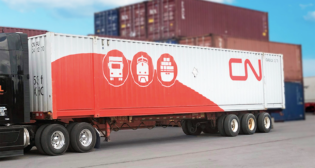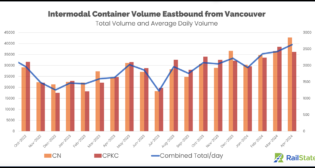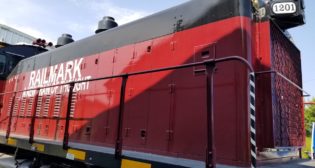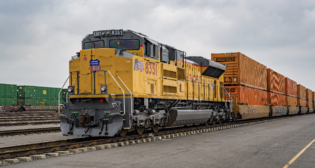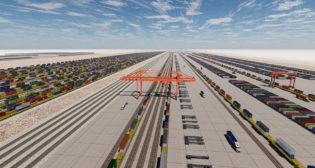
CSX collapses Howard Street Tunnel improvement project
Written by William C. Vantuono, Editor-in-ChiefCSX on Nov. 1 announced that it is cancelling its share of a long-planned P3 (public-private partnership) to rebuild and expand Howard Street Tunnel, a 122-year-old structure under downtown Baltimore originally built by the Baltimore & Ohio Railroad. The project, of which CSX’s share was $145 million, would have cleared the tunnel for double-stack intermodal trains serving the Helen Delich Bentley Port of Baltimore, which has experienced an increase in container traffic since opening of the expanded Panama Canal in 2016.
The Port of Baltimore handled a record 10.3 million tons of general freight and nearly 908,000 TEUs (20-foot-equivalent units) of containers in the fiscal year that ended June 30, according to the Maryland Port Administration. CSX cannot move double-stacks through the tunnel due to inadequate clearance. The project involved lowering the tunnel’s rail bed and raising its ceiling.
CSX, in a statement issued Nov. 1, did not fully explain its decision to pull out of the Howard Street Tunnel P3, saying:
“Since March, CSX has been adopting a new, and significantly different, operating plan called Precision Scheduled Railroading. The overall objective of this new operating plan is to drive better performance, which results in a superior service product for our customers and safer, more efficient operations.
“Given the operating changes that CSX’s new leadership team has made over the [past] several months, and upon an updated evaluation, we determined that the Howard Street Tunnel project proposal no longer justifies the level of investment required from CSX and our public partners at this time.
“Intermodal is an important part of CSX’s business, and we are committed to supporting the freight rail needs of our customers and the Port of Baltimore through frequent, reliable, on-dock service. This business decision is in no way a reflection on the leadership of [Maryland] Governor [Larry] Hogan, who has supported this initiative to the greatest degree possible on behalf of the businesses and citizens of Maryland. CSX appreciates the partnership we have developed with the State and we look forward to continuing the dialogue with our partners about our new operating plan.”
Railway Age asked CSX for clarification and more details on its decision. Spokesperson Christopher Smith sent the railroad’s Nov. 1 statement, offering no further details.
CSX’s decision to pull the plug resulted in the Maryland Department of Transportation cancelling a request to the U.S. DOT for $155 million in federal money. The Hogan Administration had developed a plan with CSX to split the cost three ways, with more-or-less equal shares footed by the USDOT, Maryland DOT and CSX. In a letter to USDOT, Maryland Transportation Secretary Pete Rahn called CSX’s decision “both surprising and incredibly troubling, especially considering the countless hours and energy that have been expended by the Hogan Administration on this effort… Improving access to our Port would have wide-ranging public benefits not only in the State of Maryland, but the entire region from Florida to the Midwest… Ultimately, as the project is [designed] to improve CSX infrastructure, Maryland cannot pursue the project without the support of CSX.”
Rahn said Maryland DOT will not submit a grant application for federal funds for the project this year. The state’s 2016 funding application was turned down, but Gov. Hogan said last December that the state would reapply.
International Longshoremen’s Association Local 333 President Scott Cowan, in an interview with the Baltimore Sun, called CSX’s decision “a big letdown” for the Port. “It’s horrible to hear,” he said. “It hurts the flow of container traffic through the port. It restricts our growth. Traffic has increased over the past year, but that’s the main sticking point right there. Double-stacking of containers through the Howard Street Tunnel is the restriction we have.”
Cowan noted that The Maryland Port Administration purchased 356 acres near Seagirt Marine Terminal for $55 million in May, to accommodate anticipated container storage growth through 2030. The acquisition marked the Port of Baltimore’s first expansion in 30 years. “The Port Administration did [its] job; [it] purchased more land,” he said. “[The tunnel] is the last piece of the puzzle. We need to get it done.”
Howard Street Tunnel was the scene of a major accident in 2001, when a 60-car CSX train derailed and set off a large chemical fire that affected downtown Baltimore for nearly one week. There were no fatalities, but the fire severely damaged the city’s underground infrastructure, causing significant flooding and disrupting rail freight traffic.
The accident piqued interest in rerouting CSX’s main line around the city or even constructing a new tunnel to the west of the existing one, but high costs put a damper on those ideas. Instead, in 2016, the state and CSX announced they had agreed on a $425 million plan ($145 million CSX; $135 million Maryland DOT; $155 million federal) to retain the existing tunnel and improve clearances to accommodate double-stack trains. CSX called the plan “transformative.”
On Dec. 23, 2016, CSX issued a news release announcing completion of its Virginia Avenue Tunnel project in Washington, D.C., calling it “the last of 61 clearance projects that comprise the $850 million National Gateway Initiative, an innovative public-private partnership announced in 2008 to create more-efficient pathways for rail freight between key U.S. markets [and] clear the way for trains to transport double-stacked intermodal freight between Mid-Atlantic seaports and the Midwest on CSX’s railroad network.”
CSX’s release also said: “On Dec. 15, Maryland submitted an application for a U.S. Department of Transportation FASTLANE grant to double-stack clear the Howard Street Tunnel and ten highway/rail crossings in Baltimore, to remove the final impediments to a fully double-stack-cleared rail corridor between Florida and New York. The Howard Street Tunnel project, if funded, will generate competitive advantages for the Port of Baltimore, remove additional trucks from the nation’s highways and create more than $640 million in benefits to 25 eastern states. CSX has committed to contribute $145 million of the funding required to complete the project.”
Speculation as to why CSX cancelled the project ranges from pressure from Mantle Ridge, the Paul Hilal-led hedge fund that installed Hunter Harrison as President and CEO, to a poor projected return on investment. CSX recently announced that it is buying back $1.5 billion in shares, prompting one observer to call the Howard Street Tunnel retreat part of “a diversion of cash from investing in infrastructure to benefit the hedge fund that brought Harrison on board.” This observer said another possible explanation is that “the volume of potential double-stacks through Howard Street Tunnel doesn’t justify a $145 million investment, despite CSX pre-Hunter saying it did.”
Other intermodal cutbacks are reportedly in the works. Unconfirmed reports say CSX will stop sorting containers at its North Baltimore intermodal terminal by mid-November, and will not build the “Carolina Connector,” a similar, $270 million facility at Rocky Mount, N.C., that had been planned to serve the Mid-Atlantic region and handle mostly local traffic.
In October, CSX began diverting traffic from its Northwest Ohio Intermodal Terminal (which in 2016 accounted for about 30% of the railroad’s total intermodal traffic), dropping service between low-volume origin and destination points both on and off its system. CSX is purportedly shifting high-volume intermodal lanes away from North Baltimore, as well as moving some intermodal traffic over to its merchandise network. A hub-and-spoke approach that included density-building container sorting and block-swapping operations to serve smaller markets appears to be on the way out.
“Baltimore doesn’t originate very much intermodal traffic since it lacks stack train clearance from either CSX or Norfolk Southern,” comments Railway Age Contributing Editor and railroad economist Jim Blaze. “The Howard Street Tunnel might logically allow between 100,000 and 200,000 imported containers to move by double-stack trains westward.
“The real tunnel requirement was to fill in the CSX I-95 Corridor gap north of Washington D.C./Virginia and south of Philadelphia. Without that tunnel, all the hype about north-south highway truck diversions between Florida and New York is just that—hype.
“Stack trains are about 35% more efficient than single-level intermodal trains. Without Baltimore as a double-stack route, other intermodal I-95 projects on CSX’s two-decade-long wish list are likely also now at risk. My questions: Where’s the traffic growth to come from for intermodal east of the Appalachian Mountains? What’s the back-up plan to grow the top line of the CSX income statement? This is a strategic economic issue.
“As my mentor Jim McClellan would probably acknowledge, ‘Things happen in a progression, with occasional up or down step-function changes.’ Removing the gap filler between DC/VA and PHL/BALT in my railroad experience is geographically a giant downward economic step-function change. That’s important, since the previous CSX board of directors wanted to consider specific business growth plans along the entire Florida/New York I-95 Corridor.
“Essentially, the winners from CSX’s Howard Street Tunnel withdrawal will probably be the truckers, and to some degree Norfolk Southern intermodal. NS has a slightly more circuitous, but double-stack cleared, route between Jacksonville and Northern New Jersey/New York City—a route NS has nurtured for two decades.
“CSX’s strategic plan following yesterday’s announcement clearly focused on the expense control of its income statement and balance sheet assets. I don’t see a recognizable strategic plan for traffic volume growth. There is, of course, an assertion of growth. But as Clara Peller used to say in those classic Wendy’s commercials, ‘Where’s the Beef?’”
